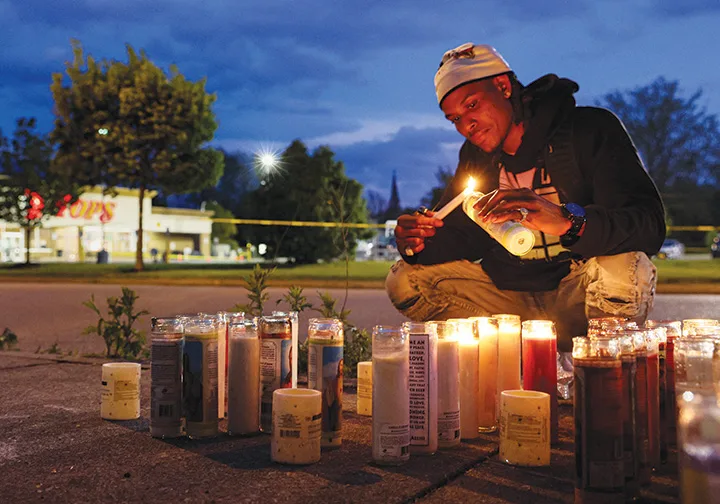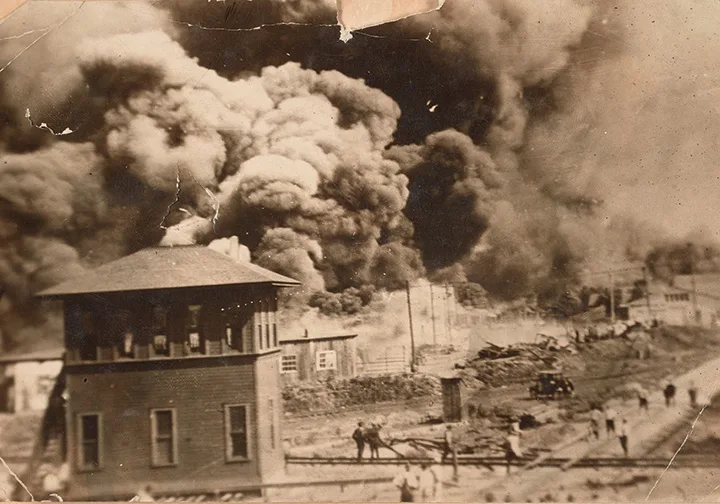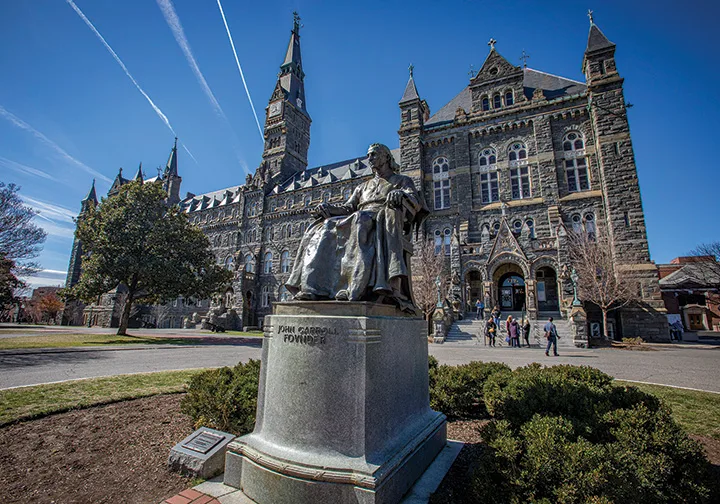
by Deacon Bill Scholl
Special to The Leaven
Oklahoma City, April 19, 1995. A terrorist attack with a massive homemade bomb concealed in a rented van explodes near a federal building killing a total of 168 people, including 19 children. As the nation reels from the devastation, a local reporter states that the bombing was the worst attack in Oklahoma history.
The reporter, however, is corrected by then-Oklahoma state Rep. Don Ross.
“No,” said Ross. “The worst one is just an hour-and-a-half away in Tulsa, Oklahoma.”
He later gave the reporter a copy of “Death in a Promised Land,” a history of the 1921 Tulsa Race Massacre.
Soon after, the national news was reporting on the 75th anniversary of one of the most horrific incidents of terrorism in American history: The Tulsa Race Massacre was a two-day rampage by a mob of white residents that destroyed Tulsa’s Greenwood district, also known as “Black Wall Street.”

It killed between 100-300 Black residents and left about 10,000 Black citizens homeless and with hundreds of Black-owned businesses and homes burned to the ground.
On learning the history, most citizens were astounded. How did we not know this happened? Why wasn’t this in our textbooks? How could we let ourselves forget something so horrible?
White identity
The almost-forgotten Tulsa massacre cries out with an all-important question that still resounds today: “What else has happened and is happening today to Black men, women and children that as a country, as a state, as a Catholic Church, we have collectively overlooked, dismissed, or most tragically, been made to forget and why?”
In his essay “On Being ‘White’ . . . and Other Lies,” author and civil rights activist James Baldwin wrote the following: “Because they think they are white, however vociferous they may be and however multitudinous, they are as speechless as Lot’s wife — looking backward, changed into a pillar of salt.”
Baldwin argued that white identity hobbles history when the victims are Black, no matter how much or many the injustice.
This is hard to hear, and yet this proposition almost becomes self-evident in my own contemplation. As a white Catholic, I want to deny it, to mitigate, to justify, to excuse.
As Catholics, we believe that racism is a grave, inherent evil. Yet, to face Black history often forces us to contend with Catholic complicity in building the structures of sin that foster a false belief in racial superiority. As Americans and as Catholics who consider ourselves “white,” we can be tempted to show a preferential option for an ignorance that confers a happy innocence on us, never noticing how it causes us to keep Blacks at a distance (emotionally and physically) lest we face the shame of what the idolatry of race has wrought.
Or perhaps in a defensive desire to not be called to account for how we gained from the crimes of our forefathers, neighbors or church leaders, we embrace a “colorblind” ideology, as if racism and its legacy are now and forever gone.
There are none so blind as those who will not see, none so deaf as those who will not hear.
Racism — the conscious or unconscious belief in racial superiority — still persists. And not recognizing the past and present experience of our brothers and sisters only makes it worse.
Wrestling with racism
The U.S. bishops remind us in “Open Wide Our Hearts,” their 2018 pastoral letter against racism, that: “The evil of racism festers in part because as a nation, there has been very limited formal acknowledgment of the harm done to so many, no moment of atonement, no national process of reconciliation and, all too often, a neglect of our history” (p.10).
One remedy they prescribe is to start listening: “As Christians, we are called to listen and know the stories of our brothers and sisters. We must create opportunities to hear, with open hearts, the tragic stories that are deeply imprinted on the lives of our brothers and sisters, if we are to be moved with empathy to promote justice” (p. 7).
So, yes, to learn Black history is to wrestle with racism. But authentic Christians do not let the anxiety of maintaining a preferred (and possibly false) identity keep them from contending with the truth. We choose instead to desegregate our personal and collective moral imagination by reconciling their stories into our story and ours into theirs. The dissonant pounding which might be shame, could also be the Lord knocking at the door of our hearts. He could be inviting us to the next leg of our life’s journey to be one as he and the Father are one (Jn 17:21). At the very least, facing the history of racism in the church warns how one can cluelessly stray from the path by the conceit of lip worship without heart (Mt15:8).
When “Open Wide Our Hearts” was released, the office for social justice and the office for Black Catholics of our archdiocese organized some racial reconciliation listening sessions. We gathered a group of Black Catholics to share their stories in integrated small groups in the parish hall at St. Joseph Parish in Shawnee.
While the stories varied from hopeful to tragic, one story struck me personally. Darren Smith, aka D.J., of Our Lady & St. Rose Parish in Kansas City, Kansas, shared the following.
“Wherever I attend Mass, I always sit in the front three rows,” he said. “I sit in front because when I was a kid, the pastor made my family sit in the back because we were Black.”
I could tell this indignity still stung and I, too, was stung when I asked him to clarify if this had happened in our archdiocese. It did. It happened in our archdiocese in the not-too-distant past.
I still think of D.J., who sadly has passed since those listening sessions, and I marvel at how he stayed Catholic. I have known of Catholics to quit at the slightest hurt feeling.
Smith, in his resolve to not let the stupidity, ignorance and hate of others keep him from the Eucharist, models for me what it means to be a Catholic man. I would never have learned this lesson had I let the fear of facing racism (my own and others) stop me.
Three million strong
As American Catholics, we have way more brothers and sisters like Smith than many of us probably realize. According to the Pew Research Center, there are currently around three million Black Catholics in the United States, making up 6% of the total population of African Americans, who are mostly Protestant, and 4% of American Catholics.
At three million, Black Catholics make up the second largest African American congregation in the United States, bigger than AME Methodist and second only to the National Baptist Convention.
However, when many Americans think about Black Christians, they don’t think Catholic. This perception is likely the result of the fact that the vast majority of African American Catholics, 76%, attend Northern European or multicultural parishes. While all the faithful share similar pastoral requirements, there has always been a need to attend to the gifts and challenges of Black Catholics.
Thus, a great, Catholic stride toward racial justice in the United States occurred when Black Catholic journalist and civil-rights activist Daniel Rudd founded the National Black Catholic Congress in 1889. The NBCC now convenes every five years to equip the church in American “to evangelize and enhance the spiritual and physical well-being of African Americans as full members of the church and society.”
Last July, Our Lady & St. Rose sent a delegation to the 13th National Black Catholic Congress. Archbishop Joseph F. Naumann interviewed several delegates afterwards on his radio show/podcast, “Shepherd’s Voice,” which aired that September.
“There are a lot of sad chapters to the history of Black Catholics in America,” said the archbishop. “And what I found in serving that community was that for Black Catholics, their faith was steel — because they were a minority within a minority, and they persevered even when their experience was not loving by others in the church community.”
Georgetown’s history with slavery
Certainly, some of those sad chapters were co-written by Catholic clergy and communities. American Catholics also recently recalled, like the people of Oklahoma, a racial injustice they had long forgotten — namely, the horrific story of the 1838 trafficking of 272 Black people, many of them Catholic, by the Jesuits to reestablish America’s first Catholic university, Georgetown. Priests callously split families apart, despite orders from Rome, in the sale to two plantation owners in Louisiana. This transaction earned about $115,000 in profit (about $3.78 million today) and is credited with saving the university.
Though a scandal at time, it was mostly forgotten by history. This tragic aspect of the Catholic Church’s origin story in America only resurfaced in 2015 when Georgetown renamed a building after Father Thomas Mulledy, the Jesuit who executed the sale. This aspect of Father Thomas’ tenure was mentioned in the announcement, and inadvertently caused an uproar from the students.

What followed was a series of news investigations. In 2016, The New York Times published an article which stirred Black Catholic journalist Rachel L. Swarns to research the history in great detail. Swarns chronicles the story in her 2023 book, “The 272: The Families Who Were Enslaved and Sold to Build the American Catholic Church.”
Again, one would understand if this research caused Swarns to quit her Catholicism. However, in an interview on the NPR show “Fresh Air,” which aired June 13, 2023, she was asked how her research impacted her faith. Swarns said, “As Black Catholic, I didn’t always see myself in the church. . . . It’s often portrayed as kind of a Northern church, an immigrant church.
“But now I see myself in the church and these families who were so determined to hold onto their faith and to make the church true to what it said it was — a universal church, a church that welcomed and accepted everyone. That has been really inspiring to me to see how they did that and how they worked to reshape the church.”
Black history can show and grow a faith of steel.
Biblical parallels
One of the ways Black history helps us wrestle with racism is to challenge our racial preference for the people who look like us to always be the heroes. Yes, it is revolting to think of our Catholic predecessors, especially clergy, perpetuating such cruel crimes. However, in not wishing to see the villain that looks like us, we can miss the hero God wants us to emulate.
Maybe this kind of reluctance is why so many in Jerusalem (both Jew and Gentile) missed the Messiah. Jesus, tortured and murdered (dare I say lynched?) but still loving his tormentors and all of us from the cross, is the hero of heroes. Yet Paul tells us that “Christ crucified was a stumbling block to Jews and foolishness to Gentiles” (1 Cor 1:23).
Maybe some who identified with the Pharisees, Sadducees or Romans who tortured and killed the Christ weren’t ready to see these men — and, by extension, themselves — as villains. Maybe the history of God becoming flesh only to suffer such a death for the sake of our sins made them too uncomfortable.
The crimes of racism image Christ on the cross. Like the cross, to gaze upon them is to see our horrible sin, but also our loving Redeemer. Look away! Look away! Look away from the gory, and you also miss the glory.
The story of the Catholic Church in America, like America itself, is not without its gore. As Edward Gibbon observed in “The History of the Decline and Fall of the Roman Empire”: “History . . . is, indeed, little more than the register of the crimes, follies and misfortunes of mankind.”
Points of light
And in this kind of telling, one can understand the reticence of white Catholics to go in search of moral flagellation to atone for racist forebears. Black Catholic history, as dark as it gets, also has brilliant points of light, the holy men and women — both Black and white — who practiced what we as a church preach. The Irish priest and future bishop, Father Joseph Carbery, did help some of the Black residents escape the Georgetown trafficking. And had it not been for the untiring advocacy of Father Peter McGirr, formerly enslaved and now-Venerable Father Augustus Tolton, who was rejected by every American seminary because he was Black, never would have gone to Rome to study and eventually be ordained as our nation’s first publicly recognized Black priest.
Yes, the cloud of witness is multiracial, but we must avoid both the narrative of “You did this to me, now say sorry and pay up!” or, “We saved you, now say thank you and shut up!”
In the Book of Genesis, we hear an account of Jacob wrestling throughout the night with a stranger, who he later realizes is God. In the contest, the stranger dislocates Jacob’s hip, a sport’s injury he’ll feel for the rest of his life.
Though hurt, Jacob refuses to let go and the stranger finally says, “Let me go, for it is daybreak.” But Jacob replies, “I will not let you go until you bless me.” It is then that God renames Jacob as Israel, which can be interpreted as “he who contends with God.”
To live, move and have our being in a world where evils such as racism exist, when in faith we know God is all powerfully good, often brings us into contention with God.
Some of us let go by quitting the faith. Some of us prevent the contest by avoiding eye-contact with the stranger.
But for those who do engage and refuse to let go until blessed, there is to be had: a faith of steel.
Deacon Bill Scholl has served as archdiocesan consultant for the office of social justice in the archdiocese for nearly 20 years. He also serves as parish administrator for Our Lady & St. Rose Church in Kansas City, Kansas. This historically Black parish, which is welcoming to all, has the distinction of being a “national” parish tasked with serving the pastoral needs of the Black Catholic community for the archdiocese. Deacon Scholl can be reached by email at: socialjustice@archkck.org.






